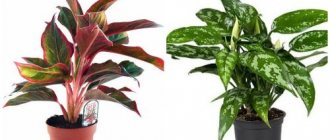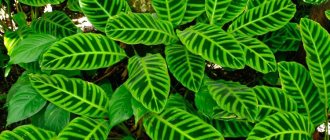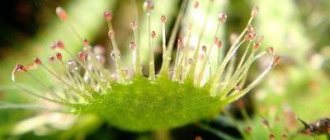Briefly about flower care
The orchid is a very capricious plant; each gardener himself chooses whether to start getting acquainted with it or not.
The orchid requires special care . How to care for tropical flowers in our climate?
The health and growth of this exotic light-loving plant primarily depends on whether it is properly lit.
Constant flowering is possible with sufficient and correct lighting . Does an orchid need light? If the leaves are pale, limp or yellow, then it’s time to organize lighting.
If in winter you do not provide additional light sources in the form of lamps, then the orchid will simply go into retirement. In some flowers, during the winter, growth may stop altogether until spring, while in others, development occurs very slowly. That is, at home, a tropical plant undergoes a forced period of rest (read more about what the conditions for keeping an orchid should be here).
How long should daylight last?
To develop a peduncle, the plant needs at least 10-14 hours of daylight per day. In tropical latitudes, the duration of effective lighting is 12 hours a day. In European summer conditions, daylight hours reach 16 hours, and in winter – only 2 hours.
The maximum illumination in summer reaches 100,000 lux, in winter - about 5,000 lux. Also, the light intensity depends on the location of the windows in the apartment and the distance of the plant from the window.
The illumination in the room is reduced by the dense development of a residential area, the presence of tall trees next to the window, and the location of the house in a lowland.
Is the plant light-loving or shade-loving?
An orchid can bloom constantly if there is enough light , but its lack leads to the elongation of leaves and pseudobulbs, the leaves become lighter. Up to a certain point, a tropical flower is able to protect itself from excess sunlight. But too much light will cause damage. Lack of lighting will slow down or even stop flowering growth.
Which option do you prefer?
To the question of how much and what kind of light an orchid needs, the answer is clear - a lot, but at the same time it is very afraid of direct sunlight. Therefore, in the summer, the indoor plant must be shaded to avoid burns, and in the cold season, when additional light is needed, it must be illuminated with additional lamps.
Orchid photosynthesis
The ground part of the orchid (leaves, stem, pseudobulbs, etc.) catch sunlight.
With the help of chlorophyll, they convert it into the energy necessary for plant development, which contributes to the creation of glucose and other organic compounds.
This process is called photosynthesis .
Photosynthesis can only occur under sufficient light conditions.
Insufficient lighting leads to the formation of a smaller amount of glucose, which is insufficient for the normal growth and development of the orchid.
In turn, excessive lighting disrupts the process of glucose formation, leading to leaf burns.
For plants, the intensity and duration of the light falling on them is important.
As the amount of light hitting the leaf increases, the rate of photosynthesis also increases proportionally.
At some point, the plant stops responding to additional lighting, as if becoming saturated.
Each type of orchid has adapted to certain lighting conditions during evolution.
Selecting a location
The ideal location for a tropical flower is near a source of natural light.
The most optimal location for growing orchids is eastern and western windows . There will be enough light here in the cold season, and in the summer there will be no burning sun rays.
On particularly hot days, in order to avoid burning the leaves, after lunch the plant must be hidden, for example, behind a tulle curtain. Windows on the south side have a beneficial effect on orchids in winter, and are very dangerous in summer.
Characteristic
There are many varieties of orchids, each of which prefers different living conditions. There are flowers that prefer the sun's rays, and there are those that are suitable for development in the shade. Sunlight is necessary for orchids such as:
The sun's rays are less in demand for orchids with pseudobulbs. And species such as phalaenopsis and Ludisia tolerate shade well, but even they need good lighting at certain times. A lack of light will cause the plant to stop blooming and instead devote its energy to growing leaves.
Lighting and shading rules
Almost every orchid loves light, but on hot days it needs to create shade; direct sunlight will damage the flower. To do this, use any translucent fabric.
Particularly sensitive species that require sunlight are illuminated with special ultraviolet lamps. Such backlights are used for a certain amount of time.
The best place
Direct sunlight destroys the plant, but many species need daylight. If there is too much light on the plant, the best option is to choose the most suitable place. Those flowers that prefer shade are placed on the windowsill. They can be located in any other location. And a plant that loves the sun is located on the windowsill.
For full development, the plant also requires proper watering and temperature conditions.
Some of the species of this plant have a root system that grows on the surface. Due to this, the flower absorbs moisture from the air. That is, it does not require too much watering, as this can cause rotting of the roots. The water is heated to room temperature before watering.
Use of fluorescent lamps
You can increase daylight hours by using additional lighting in the morning and evening hours. Fluorescent lamps are perfect for growing orchids .
The more lamps, the farther the flowers should be from them. Additional light sources may not be needed if the windows are located to the south and the flower pot is not blocked by trees and nearby houses.
You can learn more about the basic rules for caring for a flower, as well as the proper organization of lighting and types of lamps here.
Types of phytolamps
As we have already said, fluorescent lamps began to be used earlier than others to illuminate indoor plants and seedlings. Today, manufacturers have learned to change their luminescence spectrum in the range optimal for photosynthesis.
The positive qualities of these devices are low price, high light output and energy efficiency. Weaknesses include a low resource (no more than 10,000 hours) and a rapid decrease in glow strength as the lamp ages. Taking this into account, it is most profitable to install this type of lighting in greenhouses for short-term (3-4 weeks) illumination of seedlings located over a large area.
Fluorescent phytolamps generate lilac-pink light. It is harmful to vision and can cause headaches. Therefore, in residential areas they should be used with a mirror reflective screen.
Energy-saving phytolamps (housekeepers)
A modern type of fluorescent lamps. They differ from their predecessors in their compact size, long service life (15,000 hours), the presence of a built-in choke and a convenient e27 “bulb” socket.
However, experienced gardeners are not happy with them. They prefer linear fluorescent phytolamps.
They explain their choice by the fact that housekeepers have lower light output due to the tightly twisted glass tube (self-darkening effect).
Sodium phytolamps
Economical, durable, characterized by high power and stable luminous flux. The orange-yellow glow they generate is beneficial to plants and does not irritate the eyes. Therefore, this type of lamps can be used not only in greenhouses, but also in apartments. For home use (additional lighting of seedlings and flowers on the windowsill), one lamp with a power of no more than 100 W is sufficient.
In rooms where there is no sunlight, sodium lamps are used together with fluorescent lamps (LB or LBT brands).
The disadvantages of this type of lamps include the high cost of ballasts. When using sodium lamps, you need to be careful, since their bulbs get very hot (up to +300C) and can explode if water drops hit the surface.
Induction lamps
The principle of operation is similar to luminescent (an electric discharge in a glass tube initiates the glow of the phosphor). They differ significantly in design. The induction lamp has no internal electrodes, which significantly increases its service life (at least 60,000 hours). In terms of a 12-hour operating mode, this is about 20 years.
The brightness of a lamp with an induction coil decreases minimally over time (about 5%). It is not afraid of power surges and does not flicker during operation. The absence of strong heating of the bulb allows you to place induction lamps in close proximity to the plants, increasing the lighting intensity.
Their color rendition is as close as possible to the spectrum of sunlight. Therefore, induction lamps can be used without combining with other sources of phytolight. The main disadvantage of these lamps is their high cost.
LED phytolamps
When creating phytolights, designers did not ignore LEDs. They have many important advantages. Consuming a minimum of energy, LEDs generate powerful radiation. Its spectral composition is selected quite simply (by installing a certain number of blue and red diodes).
LED lamps for plants differ from other phytolight sources in their long service life (about 50,000 hours) and stable radiation characteristics, which are little dependent on the period and operating conditions. The heating of the LED module is low, which eliminates the risk of burning plants. Compact placement in the same block with the ballast lamp, the use of a standard “bulb” base simplifies and reduces the cost of their use as lighting.
How to darken?
Tropical plants love bright and at the same time diffused light . This can be created at home using transparent fabric, such as curtains. In spring, orchids growing on the windowsill must be shaded from the sun. It is better to move the flower at a distance of 1-1.5 meters from the window.
You can shade a tropical plant on the windowsill using a thick sheet of paper, a mosquito net or blinds.
We invite you to watch a video on how to make shading for orchids:
What is improper lighting and what are its consequences?
Now that we have figured out whether an orchid is a light-loving plant or not, it is important to determine whether the tropical plant is illuminated correctly. The indicator in this case is the leaves. In a healthy orchid they are bright green. If the leaves darken, the plant clearly does not have enough light; if they turn yellow or take on a reddish tint, there is too much light.
Does the plant love the sun enough to thrive in direct sunlight? No - they are the main enemy of tropical flowers and can cause leaves to burn. Windows located on the south side are especially dangerous . It is best to place exotic flowers on northern, eastern and western windows.
Trees growing nearby and houses standing opposite can save you from the hot sun. The orchid loves the sun, but intense lighting can lead to tanning of the plant and, as a result, pigmentation; this is not scary and does not require treatment; it is enough to move the flower into the shade. But burned leaves will not recover until they die naturally. Lack of light also negatively affects the life of a tropical flower. Therefore, from autumn to the end of winter it is necessary to use backlighting.
Proper lighting is of great importance in caring for orchids . They require a lot of light and no direct sunlight. In summer, it is better to keep pots with exotic flowers on windows facing east and southeast, and in winter, to the west and southwest. If there is insufficient lighting, lamps must be used.
Types of photosynthesis in orchids
Currently, several types of photosynthesis have been identified in orchids:
- C3 photosynthesis;
- C4 photosynthesis;
- CAM (Crassulacea Acid Metabolism);
- C3-SAM (self-switching photosynthesis).
C3 photosynthesis
During C3 photosynthesis, carbon dioxide enters the plant through open stomata, both during the day and at night.
The peculiarity of C3 photosynthesis is that the absorption of carbon dioxide occurs in one place of the leaf, and its processing in another.
C4 photosynthesis
During C4 photosynthesis, the stomata are partially covered during the day. Such photosynthesis is an adaptation of plants to survive drought, high temperatures, salinity of the substrate and lack of carbon dioxide.
CAM photosynthesis
During CAM photosynthesis , plants close all stomata during the day to avoid excessive water loss, and the absorption and transformation of carbon dioxide occurs only at night.
The same type of carbon storage is used by desert plants - cacti and succulents.
Self-switching C3—CAM photosynthesis
Self-switching C3-CAM photosynthesis is quite widespread among epiphytic and lithophytic orchids from regions with a clear alternation of dry and wet seasons.
Under favorable climatic conditions (optimal temperature, sufficient light), the stomata of these orchids are open during the day, carbon dioxide enters the plant during the day, and they function like ordinary plants with C3 photosynthesis.
As soon as the conditions change dramatically (lack of water, lack of light, a strong decrease in night temperatures, excess salts in irrigation water, etc.), the orchid switches to night-time consumption of carbon dioxide according to the CAM type.
CAM orchids close their stomata during the day to minimize water loss. They breathe and absorb carbon dioxide and water only in the dark, at low temperatures and high humidity.
Almost all orchids with thick, fleshy leaves are prone to self-switching C3 - CAM photosynthesis , this is especially true for monopodially growing orchids, including Phalaenopsis.
In conditions of high air humidity and good light, plants consume carbon dioxide, resorting to C3 photosynthesis, leaving stomata open during the day, quickly increase biomass and bloom easily .
As soon as the conditions for keeping orchids deteriorate, it becomes a plant ITSELF, whose leaves thin out, become smaller and grow more slowly .
Light compensation point
When the intensity of photosynthesis (the amount of carbon dioxide consumed) and respiration (the amount of carbon dioxide released) are equalized, the so-called light compensation point .
In shade-tolerant orchids, the light compensation point is 1% of total illumination (250-300 lux), in light-loving orchids - 3-5% (800-2000 lux).
The formation of new cells begins after increasing this light level. With a lack of light, the plant becomes depleted.
Three states of the orchid can be distinguished :
- Being at the compensation point - nothing happens.
- Being in a state ABOVE the compensation point - the orchid begins to grow roots, leaves, etc.
- Being in a state BELOW the compensation point - the leaves and roots dry out, and as a result the plant dies.
In addition to illumination, the light compensation point is strongly dependent on temperature.
The higher the temperature , the more actively plants respire, which causes additional energy costs and upsets the balance between the production and consumption of carbohydrates during photosynthesis and respiration.
The orchid begins to give back more than it produces, and compensates for the lack of carbon by taking it from old leaves, shoots and roots.
Previously accumulated nutrients are spent only on maintaining one’s own vital functions, and there is no energy left for development.
IMPORTANT! High temperatures at night are harmful to orchids, as is low light during the day, since they prevent the fixation of carbon dioxide.
An orchid growing at constantly elevated temperatures and low light levels stops forming flower stalks, thus trying to save some of the energy spent on breathing.
If the situation has not changed, the temperature remains high and respiration still prevails over photosynthesis, shoots and leaves begin to shrink .
As a result, small pseudobulbs and leaves will not be able to accumulate sufficient nutrients for next year's growth.
smaller and smaller every year .
Such negative development dynamics can result in the death of the plant.
The maximum productivity of photosynthetic reactions in plant cells of C3 orchids is observed in the temperature range of 20–35 °C.
At higher temperatures , the intensity of photosynthesis decreases, and at temperatures above 42 ° C, irreversible processes occur in the orchid’s body, leading to burns or even death.
At daytime temperatures of 13 °C and below, the intensity of photosynthesis also decreases.
A decrease in night temperatures is one of the main conditions for the growth of green biomass and the formation of flower stalks.
If the room is hot at night ( above 24 °C ), the process of formation of new tissues slows down, and the plant again takes carbon from its old organs - leaves, stems, peduncles and roots.
When it becomes too hot ( above 32 °C ) and dry (humidity drops below 70%), carbon dioxide from the air stops flowing into the leaves through the stomata.
Instead, the reverse process occurs through them - the release of moisture, which protects the plant from overheating.
Having given up all possible water, the stomata close for a long time, and the plant's photosynthesis switches from C3 to CAM to prevent leaf wilting from excessive evaporation.
With prolonged CAM mode, irreversible processes can begin in orchid leaves, during which their cells begin to gradually die.
In winter, special attention should be paid to caring for orchids when kept at home.
Low light on the windowsill requires lowering the temperature.
At low temperatures , the intensity of photosynthesis decreases, and a short day reduces the period of already ineffective photosynthetic activity of the plant.











